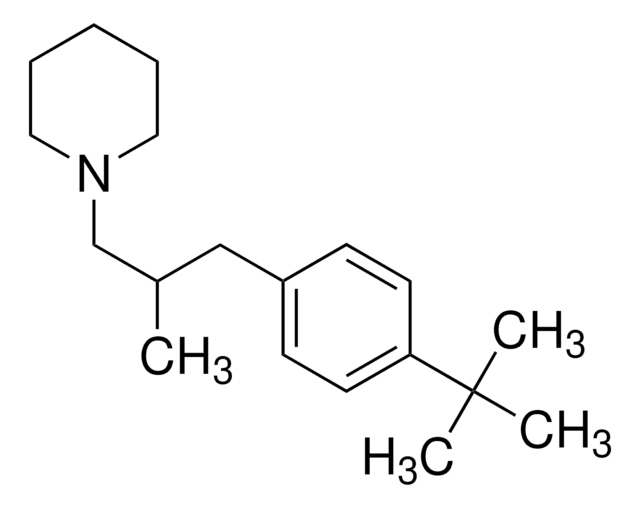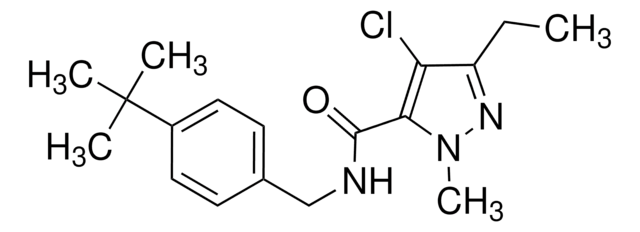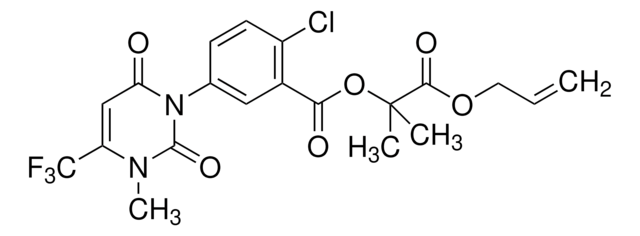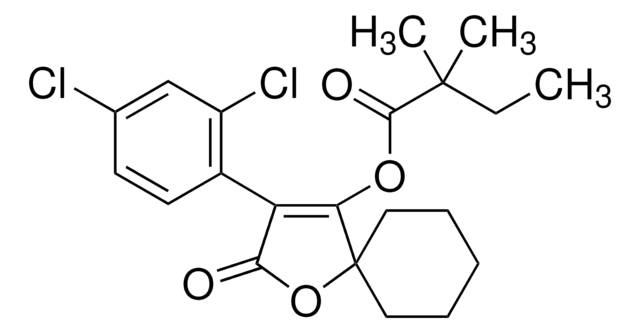CRM52554
Spiroxamine
certified reference material, TraceCERT®, Manufactured by: Sigma-Aldrich Production GmbH, Switzerland
Sinonimo/i:
N-Ethyl-N-propyl-8-tert-butyl-1,4-dioxaspiro[4.5]dec-2-ylmethylamine
About This Item
Prodotti consigliati
Grado
certified reference material
TraceCERT®
Livello qualitativo
Nome Commerciale
TraceCERT®
Durata
limited shelf life, expiry date on the label
Produttore/marchio commerciale
Manufactured by: Sigma-Aldrich Production GmbH, Switzerland
Formato
neat
Temperatura di conservazione
2-8°C
Stringa SMILE
CCCN(CC)CC1COC2(CCC(CC2)C(C)(C)C)O1
InChI
1S/C18H35NO2/c1-6-12-19(7-2)13-16-14-20-18(21-16)10-8-15(9-11-18)17(3,4)5/h15-16H,6-14H2,1-5H3
PUYXTUJWRLOUCW-UHFFFAOYSA-N
Cerchi prodotti simili? Visita Guida al confronto tra prodotti
Descrizione generale
Certified content by quantitative NMR incl. uncertainty and expiry date are given on the certificate.
Download your certificate at: http://www.sigma-aldrich.comSpiroxamine is a systemic fungicide that belongs to the class of synthetic amines or morpholines. It targets the ∆14-reductase enzyme and inhibits sterol biosynthesis. It is used against powdery mildew, rust, and spot fungi on cereals and grapes for its protective, curative, and eradicative activities.
As per Regulation (EC) No. 1107/2009, repealing directive 91/414/EEC, spiroxamine is approved for use in the European Union (EU). A maximum residue limit (MRL) of 0.01 mg/kg and 0.05 mg/kg is applicable for the presence of spiroxamine in fresh/frozen fruits and tree nuts respectively, in accordance with Regulation (EC) No. 2016/452. Spiroxamine is to be monitored in the Multiannual Control Programme for Pesticides Residues (MACP), run within the EU and EFTA in/on products of plant origin.
Applicazioni
The spiroxamine CRM may also find the following uses:
- Development of an enantioselective method to determine three fungicide residues in grapevine, sugar beet, and wheat samples by gas chromatography-tandem mass spectrometry (GC-MS/MS)
- Quantification of 19 neonicotinoids and fungicides from pollen and individual bumblebee samples using modified QuEChERS extraction with ultra-high performance liquid chromatography-tandem mass spectrometry (UHPLC-MS/MS)
- Evaluation of a gas chromatographic method with electron capture and nitrogen phosphorus detection (GC/ECD/NPD) for the analysis of 46 pesticides in fresh peppermint samples
- Multi-residue determination of 25 pesticide residues in red wine by gas chromatography-mass spectrometry(GC-MS)
- QuEChERS extraction and liquid chromatography-tandem mass spectrometry based determination of 42 pesticides in six marijuana samples
- Investigation of three different sample preparation methods to select the most suitable one for the analysis of 98 pesticides in globe artichoke leaves and fruit samples by LC-MS and GC-MS
Note legali
Non trovi il prodotto giusto?
Prova il nostro Motore di ricerca dei prodotti.
Avvertenze
Warning
Indicazioni di pericolo
Classi di pericolo
Acute Tox. 4 Dermal - Acute Tox. 4 Inhalation - Acute Tox. 4 Oral - Aquatic Acute 1 - Aquatic Chronic 1 - Repr. 2 - Skin Irrit. 2 - Skin Sens. 1 - STOT RE 2
Organi bersaglio
Eyes
Codice della classe di stoccaggio
10 - Combustible liquids
Classe di pericolosità dell'acqua (WGK)
WGK 3
Punto d’infiammabilità (°F)
296.6 °F
Punto d’infiammabilità (°C)
147 °C
Scegli una delle versioni più recenti:
Certificati d'analisi (COA)
Non trovi la versione di tuo interesse?
Se hai bisogno di una versione specifica, puoi cercare il certificato tramite il numero di lotto.
Possiedi già questo prodotto?
I documenti relativi ai prodotti acquistati recentemente sono disponibili nell’Archivio dei documenti.
Il team dei nostri ricercatori vanta grande esperienza in tutte le aree della ricerca quali Life Science, scienza dei materiali, sintesi chimica, cromatografia, discipline analitiche, ecc..
Contatta l'Assistenza Tecnica.











